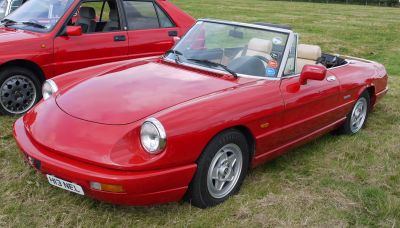 1990 Porsche 911 Targa (964) Dimensions, Size & Specs
1990 Porsche 911 Targa (964) Dimensions, Size & SpecsMeasurements of the 1990 Porsche 911 Targa, engineered for optimal performance and comfort
| Dimensions | |
|---|---|
| Length: | 4250 mm167.3 in13.9 ft |
| Width: | 1652 mm65.0 in5.4 ft |
| Height: | 1310 mm51.6 in4.3 ft |
| Ground Clearance: | 120 mm4.7 in0.4 ft |
| Weight Specifications | |
| Curb Weight: | 1350-1450 kg2976-3197 lbs |
| Maximal permitted Weight: | 1690-1790 kg3726-3946 lbs |
| Tire Specifications | |
| Rims Sizes: | 16-inch rims:
|
| Tire Sizes: |
|
The Porsche 911 Targa (964) is an iconic cabriolet model produced between 1989 and 1993, with the 1990 model year being a pivotal example of this generation. As part of the 964 series, this classic Porsche combines the timeless design of the 911 lineup with unique Targa features, such as its signature removable roof panel and distinctive rear window. The 911 Targa (964) measures 4250 mm (167.3 inches) in length, 1652 mm (65 inches) in width, and stands at a height of 1310 mm (51.6 inches). These dimensions give it a compact yet sporty profile ideal for both city driving and spirited road experiences. Weighing between 1350 to 1450 kilograms (2976 to 3197 pounds), the vehicle maintains a balance between lightweight agility and solid build quality. Its maximum gross weight ranges from 1690 to 1790 kilograms (3726 to 3946 pounds), indicating a robust capacity for passengers and cargo. Ground clearance is set at 120 mm (4.7 inches), which supports the Porsche’s sporty handling dynamics while still providing enough clearance for typical road conditions. The 911 Targa rides on wheels sized 8J x 16 and 6J x 16, fitted with tires sized 225/50 R16 and 205/55 R16, offering a blend of grip and comfort suited for its performance ambitions. This model stands out not only for its dynamic driving capabilities but also for its elegant styling and practical cabriolet design, making the Porsche 911 Targa (964) a cherished classic among enthusiasts and collectors alike.
Discover the standout features that make the 1990 Porsche 911 Targa a leader in its class
Have a question? Please check our knowledgebase first.
The Porsche 911 Targa (964) produced between 1989 and 1993 has a length of 4250 mm (167.3 inches), a width of 1652 mm (65.0 inches), and a height of 1310 mm (51.6 inches). These dimensions reflect a compact yet sporty body style typical of the 911 series. Its relatively low height enhances aerodynamic efficiency and sporty driving dynamics, while the width provides stability and road grip. The Targa model specifically features a distinctive removable roof panel which adds to its sporty appeal without significantly increasing external dimensions compared to coupé versions.
The curb weight of the Porsche 911 Targa (964) ranges from 1350 kg to 1450 kg (approximately 2976 lbs to 3197 lbs), depending on specific configurations and optional equipment. The maximum permissible weight ranges between 1690 kg and 1790 kg (3726 lbs to 3946 lbs). This lightweight build relative to other sports cars of its era supports impressive agility, quick acceleration, and dynamic cornering capabilities. The modest weight also aids in fuel efficiency and braking performance. The balance of weight distribution in the 911 Targa lets the car maintain its hallmark nimbleness and responsive handling.
The Porsche 911 Targa (964) features a ride height or ground clearance of 120 mm (4.7 inches). This relatively low ground clearance enhances the car's aerodynamic profile and improves handling by lowering the center of gravity, which contributes to better stability and cornering precision. However, the low clearance can pose challenges on uneven roads, speed bumps, and driveways, requiring careful navigation to avoid scraping the underside. For everyday usability, drivers need to be mindful of road conditions, but the trade-off significantly benefits driving dynamics and performance.
The 1990 Porsche 911 Targa (964) comes equipped with rims sized 8J x 16 at the front and 6J x 16 at the rear, paired with tire sizes 225/50 R16 in the front and 205/55 R16 in the rear. These dimensions support excellent road contact and grip, important for maintaining the 911’s renowned handling and cornering capabilities. The tire profiles and widths are well balanced to provide a responsive steering feel, optimal traction, and a comfortable ride without compromising sporty dynamics. These sizes reflect a typical configuration of the early 1990s sports cars, favoring driver engagement and stability.
Yes, the Porsche 911 Targa (964) fits comfortably into a standard home garage. With a length of 4250 mm (167.3 inches) and a width of 1652 mm (65.0 inches), it is relatively compact compared to many modern vehicles. Standard garages typically accommodate vehicles up to around 6 to 7 meters (236 to 275 inches) in length and about 2.5 meters (98 inches) in width, so parking the 911 Targa will pose no spatial issues. Its height of 1310 mm (51.6 inches) is low enough to permit easy clearance in most garages, making storage convenient without special arrangements.
Compared to its predecessor, the Porsche 911 Targa from the G-Series (produced until 1989), the 964 generation saw some notable refinements in size and weight. The 964 is slightly larger in length (4250 mm vs. approximately 4200 mm) and width, bringing a more modern presence without drastically increasing footprint. Weight-wise, the 964 aimed to maintain or slightly reduce curb weight through advanced materials and design, despite added technology and structural reinforcements. This balance helped preserve the 911’s agility while offering improved comfort, safety, and performance, making it a superior evolution rather than a radical size change.
The Porsche 911 Targa (964) of the early 1990s is similar in size to other compact luxury sports cars of that era. For example, compared to the 1990 Jaguar XJ-S convertible or the BMW E30 M3 convertible, the 964 is slightly shorter in length but comparable in width and height. The 911’s design maximizes performance-oriented dimensions that prioritize lightweight construction and aerodynamics, resulting in a relatively smaller but sportier footprint. While competitors may be broader or longer due to different design philosophies, the 964 strikes an excellent balance of size for spirited driving coupled with practical everyday usability.
The Porsche 911 Targa (964) offers a relatively snug interior focused on driver and passenger engagement rather than passenger volume or cargo space. Seating is designed for two with limited rear seat space, often considered best suited for small adults or children. The front luggage compartment provides moderate storage capacity suitable for day trips or light travel, with about 125 liters (4.4 cubic feet) of front trunk space. The absence of a traditional rear trunk due to the rear-engine layout limits total cargo space. Owners often use supplemental storage solutions for longer journeys, but the car balances sportiness with practical use for weekend or short trips.
The Porsche 911 Targa (964) incorporates significant aerodynamic and structural upgrades compared to earlier models. Its slightly wider body and smoother lines improve airflow and reduce drag, enhancing stability at high speeds. The introduction of a more integrated bumper design, flush-mounted glass, and subtle spoilers further optimize airflow. Structurally, the 964 features a more robust chassis and improved torsional rigidity, especially important for the Targa’s removable roof design. These refinements slightly increased overall body dimensions but improved vehicle dynamics, safety, and driving precision, making the car both sportier and more comfortable to drive at elevated speeds.
The Porsche 911 Targa (964) cabriolet stands out with its unique roof design—a removable glass roof panel combined with a fixed rear window, providing a blend of open-top driving and coupe-like protection. Produced from 1989 to 1993, the model featured advancements such as improved chassis rigidity, power steering, ABS brakes, and updated suspension compared to earlier generations. It maintained the classic rear-engine layout and sporty 911 silhouette while integrating modern technology for enhanced comfort and safety. The Targa model caters to enthusiasts seeking the open-air experience without fully compromising structural integrity.
Discover similar sized cars.

| Production: | 1966-1993 |
|---|---|
| Model Year: | 1970 |
| Length: | 4260 mm167.7 in |
| Width: | 1630 mm64.2 in |
| Height: | 1290 mm50.8 in |

| Production: | 1966-1977 |
|---|---|
| Model Year: | 1966 |
| Length: | 4250 mm167.3 in |
| Width: | 1630 mm64.2 in |
| Height: | 1290 mm50.8 in |

| Production: | 1989-1994 |
|---|---|
| Model Year: | 1990 |
| Length: | 4250 mm167.3 in |
| Width: | 1650 mm65.0 in |
| Height: | 1310 mm51.6 in |

| Production: | 1989 |
|---|---|
| Model Year: | 1989 |
| Length: | 4250 mm167.3 in |
| Width: | 1652 mm65.0 in |
| Height: | 1280 mm50.4 in |
